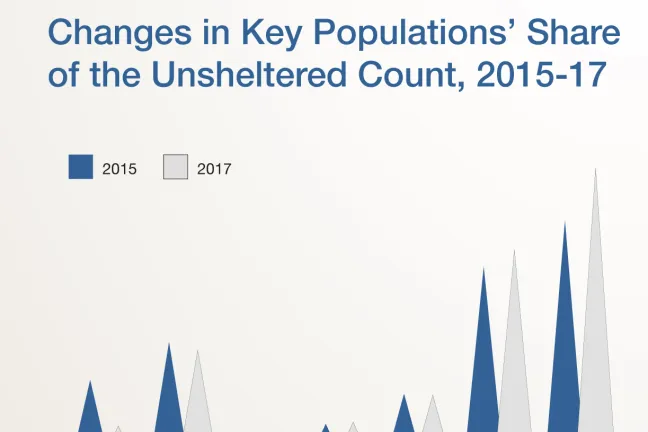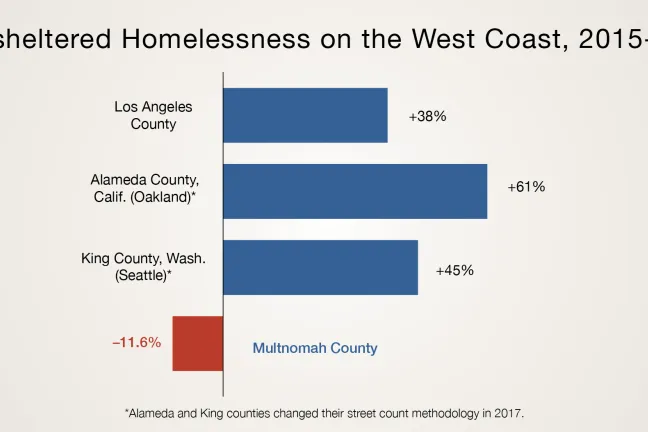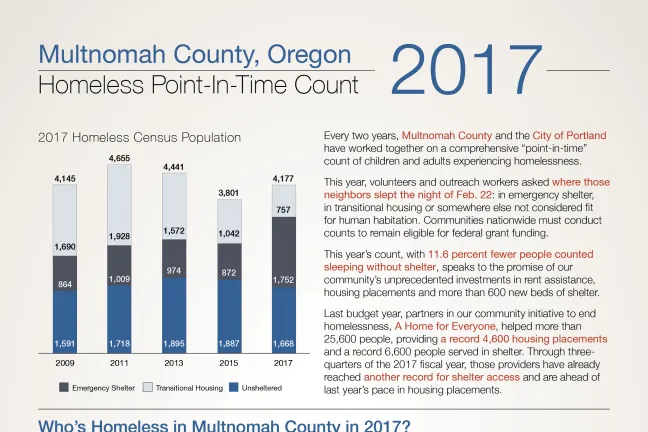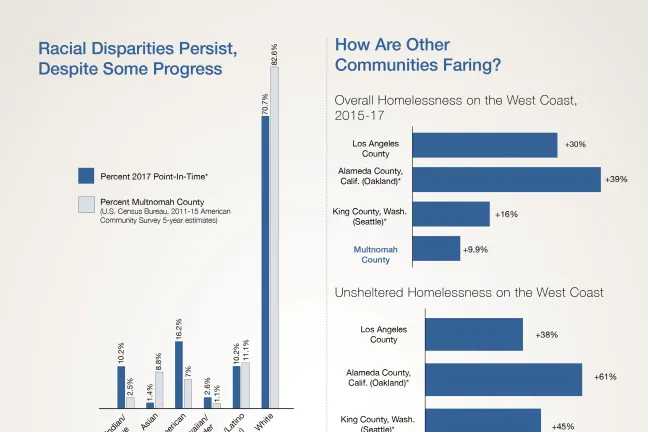Overall, the number of people experiencing homelessness in Multnomah County has increased, according to the 2017 Point in Time count, but a larger share of those neighbors slept in shelter and off the street.
The results, released by the Joint Office of Homeless Services on Monday, June 19, are the first to emerge since local governments committed $20 million in new spending to confront the crisis on our streets.
The 2017 count found 12 percent fewer people were sleeping unsheltered in cars, tents and other outdoor places on Feb. 22 than were in 2015 -- 1,668 people. That decline marks a reversal after several years in which the unsheltered count surged or held steady. This year’s unsheltered count is the lowest it’s been since 2009.
Notably, the drop in the unsheltered count included reductions among groups the City of Portland and Multnomah County prioritized after their numbers spiked two years ago: African Americans, women, veterans, and families with children.
The count of unsheltered African Americans fell by almost half, from 396 to 169. But even with this year’s improvements, African Americans and other communities of color continue to suffer from disproportionately high rates of homelessness.
Increasing shelter was a top priority for A Home for Everyone, our community-wide initiative to end homelessness. The partners added more than 600 shelter beds since January 2016, nearly doubling the number of publicly funded spaces available.
A briefing memorandum on the numbers was set to be discussed by Monday’s 2 p.m. meeting of A Home for Everyone’s executive committee. A more-detailed report on the results, prepared by Portland State University, will be available this summer.
“Like communities up and down the West Coast with rapidly rising rents and stagnant incomes for our lowest-income residents, this year’s count shows, once again, that thousands of our neighbors experience homelessness on any given night,” said Marc Jolin, director of A Home for Everyone and the Joint Office of Homeless Services.
“But the data also shows us that our local interventions matter,” he said. “By investing in prevention, housing placement and shelter, we brought the overall unsheltered number down, and ensured that thousands of people who otherwise might have been unsheltered on the night of the count were instead in emergency shelter or in permanent housing.”
Increase in chronic homelessness and reported disabilities
The reported decline in people sleeping without shelter is a step forward, in that it likely means hundreds more people had a safer place to sleep. But it’s important to note that the decrease in the unsheltered count doesn’t directly correlate to changes in the visibility of homelessness.
Several of the more than 1,600 people counted sleeping outside rely on tents and visible structures. And those structures became more prominent last year, in highly visible locations, amid attempts to balance livability enforcement against the right to safe sleep.
People who report disabilities also make up a larger share of this year’s unsheltered count, close to 72 percent. And the number of people considered chronically homeless in this year’s count also has increased. People in those categories often struggle with health and addiction issues that complicate efforts to bring them into housing.
Those issues, in turn, tend to draw more community attention when they play out in public instead of in private. In addition, many shelter beds in our community open up at night and close early in the morning, meaning they aren’t able to offer refuge away from public places for hundreds of people during the busiest parts of the day.
Major expansions in housing placements, shelter capacity
This year’s reduction defies trends in communities up and down the West Coast. Alameda County’s (Oakland, California) unsheltered count has climbed 61 percent in two years. Los Angeles County saw a 38 percent rise, with the increase in King County (Seattle, Washington) at 45 percent. (Both King County and Alameda County moved to a more intensive street count method this year.)
Portland and Multnomah County suffer from many of the same economic pressures -- rising housing costs and growing income disparities -- as those places. But our community has also worked hard since 2015 to better align and increase investments in homelessness services.
Beyond expanding shelter, partners also expanded resources for prevention services and housing placements, strategies that help more people leave shelter quickly or avoid it altogether.
“We all need to work together to help people out of poverty and homelessness. That’s why our partnership, A Home For Everyone, is so critical,” said Multnomah County Chair Deborah Kafoury, a co-chair of A Home for Everyone. “Too many people are sleeping on our streets. But by investing in housing and wraparound services, we are making a difference in the lives of thousands of people every year.”
Shelter can provide a chance for safe sleep and stability on the way to regaining housing. Because of our investments, the number of people counted in emergency shelter climbed to 1,752 this year, a little more than double the count in 2015. The number of chronically homeless adults counted in shelter also nearly doubled since 2015.
For the first time since 2005, when our community first counted people experiencing homelessness, more people were counted in emergency shelter than sleeping on the streets.
That partly reflects adding a no-turn-away family shelter and more capacity for families. Though the number of people counted in households with children held steady, the number of unsheltered people in families dropped by 49 percent.
The increase in people sleeping in emergency shelter also shows our community’s commitment to adding lower-barrier capacity. Partners have added spaces for couples, shift workers and pet owners, some of whom may not have engaged with traditional shelter options. Those new spaces are available 24/7 and offer opportunities to take showers and store belongings.
Multnomah County and the City of Portland also added dozens of temporary beds this winter. Those efforts relied on strong relationships between government and members of the business community, who offered space in vacant buildings awaiting development to help more of their neighbors find a safe place off the streets.
“The challenges around homelessness are serious and varied. Over the last two years, we created the Joint Office of Homeless Services and have made record investments in homeless services,” said Portland Mayor Ted Wheeler, a co-chair of A Home for Everyone. “This report provides reason for optimism that our strategy is working.”
Spiking rents, stagnant wages still forcing more people into homelessness
Despite this progress, our community still confronts a crisis caused by stagnant wages for low-income people, increasingly unaffordable housing costs, decades of federal disinvestment, racial bias, and the pain and trauma left by cycles of poverty.
Since 2015, rents in the Portland-area have risen 20 times faster than the median income, to more than $1,100 for a one-bedroom apartment. More than 18,000 people in Multnomah County rely on long-term federal disability checks that top out at $735.
High housing costs aren’t only pushing people into homelessness. They’re also making it more expensive to help people regain housing once they’ve lost it.
This year, even though we counted fewer people without shelter, the overall number count of neighbors who met the federal definition of homelessness -- meaning they slept outside, in emergency shelter or in transitional housing -- climbed to 4,177. That’s a nearly 10 percent increase since 2015.
That shows that even though more people have a safer place to sleep this year, our community must redouble its efforts to keep people from losing their homes or to quickly put them back into housing if they do.
The number of people considered chronically homeless or who reported disabling conditions climbed at a higher rate than the overall number of people experiencing homelessness. The number of unaccompanied youths 24 and younger also increased more sharply than the overall count, up to 300.
Women and seniors continued to see their share of the overall homeless population grow. And more people, compared to 2015, also reported being homeless for two years or more. Providers continue to warn that it takes longer and longer for some people to find housing because of the market.
More milestones for the community’s work in A Home for Everyone
Those trends would almost certainly be more dire without our community’s work.
In 2014, community partners convened by the County and City agreed to create A Home for Everyone, our region’s first community-wide plan for tackling homelessness.
Last summer, the City and County each invested an additional $10 million in homelessness work and created the Joint Office of Homeless Services to align and manage that spending.
Last fiscal year, across all of A Home for Everyone’s partners, more than 25,600 people received some level of services -- the most ever. That includes a record 4,600 people returned to housing and more than 5,200 who received prevention services.
Data from the first nine months of this fiscal year, which ends June 30, shows A Home for Everyone is on track to meet its goals. Already, the number of people served in shelter has exceeded the total in all of the 2015-16 fiscal year. And partners who help with housing placements have helped hundreds more people than at the same point last fiscal year.
Data from the 2015 count helped shape A Home for Everyone’s goals and spending priorities. That’s one reason why partners invested more effort in working with veterans, domestic violence victims and communities of color over the past two years.
So far in the current fiscal year, service providers report that at least 67 percent of those receiving prevention assistance are people of color. Among people placed into housing, at least 62 percent are people of color.
Data from this year’s count will continue to guide strategies and funding allocations. Data from this year’s report will inform A Home for Everyone’s work to address chronic homelessness.
"This data shows our strategies are making a difference. But it also provides a sobering confirmation of what I see regularly in the emergency room" said Multnomah County Commissioner Sharon Meieran, an emergency room physician and a member of A Home for Everyone’s executive committee.
"People living on our streets are those who are vulnerable, including those who suffer from persistent mental and physical health challenges,” she said. “We must use this new data judiciously, to help us improve our systems and support for people who have nowhere else to turn."
Document




